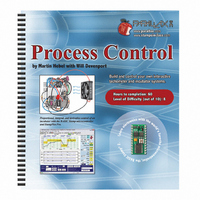122-28176 Parallax Inc, 122-28176 Datasheet - Page 241

122-28176
Manufacturer Part Number
122-28176
Description
GUIDE STUDENT PROCESS CONTROL
Manufacturer
Parallax Inc
Specifications of 122-28176
Accessory Type
Manual
Product
Microcontroller Accessories
Lead Free Status / RoHS Status
Contains lead / RoHS non-compliant
For Use With/related Products
Propeller Education (PE) Kit
Lead Free Status / RoHS Status
Lead free / RoHS Compliant, Contains lead / RoHS non-compliant
- Current page: 241 of 330
- Download datasheet (11Mb)
Challenge 7-1
Part A: Stand-Alone Control with Fan
Part B: Op-Amp Temperature Setpoint Detection
Consider the On-Off op-amp configuration in Figure 7-6. Instead of using an ADC for
measuring temperature, how could this configuration be used to simply indicate to the
BASIC Stamp if a temperature is above or below a given value?
ACTIVITY #2: DIFFERENTIAL GAP CONTROL
The rapid cycling resulting from noise or the measurement hovering around a single
setpoint is the biggest disadvantage of simple on-off control. Most practical on-off
control systems lend themselves to allowing a minimum and maximum value of
measurement. Good examples are the air conditioners or heaters in your home. Your
furnace does not kick on just above your thermostat setting, and off just below it.
Whether using a mercury switch or an electric thermostat, there is a control gap. If it is
set for 68 °F, it may kick on at 66 °F and off at 70 °F. This allows a 4 degree gap for
control to prevent the unit from continually cycling on and off over a very short period of
time, which wastes energy and stresses the mechanical components. For ideal hatching
of eggs with the incubator, it is allowable to have a 0.5-degree variance from the setpoint
allowing control between 101.0 °F and 102.0 °F.
Differential-gap control is a mode of control that takes action based on the measurement
crossing a defined upper and lower limit. When the measured value goes beyond one
√
√
√
√
√
Save IncubatorOnOff.bs2 under the name IncubatorOnOffFan.bs2.
Modify your program to control temperature at 101.5 °F with no interactive
control with StampPlot. Refer back to the Stand-Alone Control Challenge on
page 217 for hints on accomplishing this. Use StampPlot for monitoring only to
ensure proper operation.
Modify the program to energize the fan should temperature exceed the setpoint
by 3 degrees. It should turn off once the temperature falls below that limit.
Write your modified code, and capture a plot of the control action. To achieve
104.5 °F, you may either rely on overshoot from a low temperature or remove
the incubator canister and briefly use a lighter.
Draw a schematic and show control code for this.
Related parts for 122-28176
Image
Part Number
Description
Manufacturer
Datasheet
Request
R

Part Number:
Description:
MANUAL FOR SUMOBOT
Manufacturer:
Parallax Inc
Datasheet:

Part Number:
Description:
GUIDE STUDENT SMART SENSORS
Manufacturer:
Parallax Inc
Datasheet:

Part Number:
Description:
MANUAL PROPELLER
Manufacturer:
Parallax Inc
Datasheet:

Part Number:
Description:
LEAD WIRES FLYING CABLE III/IV
Manufacturer:
Xilinx Inc
Datasheet:

Part Number:
Description:
BOARD ADAPTER AND FLY LEADS
Manufacturer:
Xilinx Inc
Datasheet:

Part Number:
Description:
PLATFORM CABLE USB II
Manufacturer:
Xilinx Inc
Datasheet:

Part Number:
Description:
KIT STARTER COOLRUNNER-II BUNDLE
Manufacturer:
Xilinx Inc
Datasheet:

Part Number:
Description:
Microcontroller Modules & Accessories DISCONTINUED BY PARALLAX
Manufacturer:
Parallax Inc

Part Number:
Description:
Microcontroller Modules & Accessories DISCONTINUED BY PARALLAX
Manufacturer:
Parallax Inc

Part Number:
Description:
BOOK UNDERSTANDING SIGNALS
Manufacturer:
Parallax Inc
Datasheet:

Part Number:
Description:
BOARD EXPERIMENT+LCD NX-1000
Manufacturer:
Parallax Inc
Datasheet:

Part Number:
Description:
IC MCU 2K FLASH 50MHZ SO-18
Manufacturer:
Parallax Inc
Datasheet:












